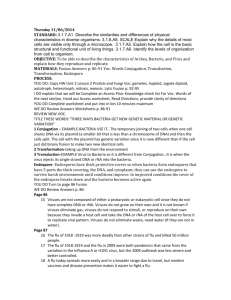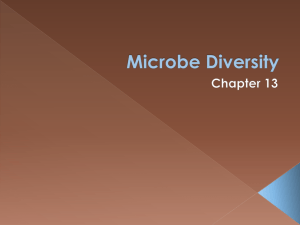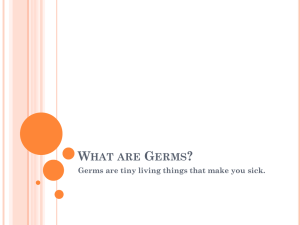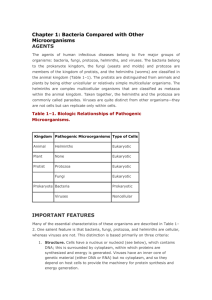File
advertisement
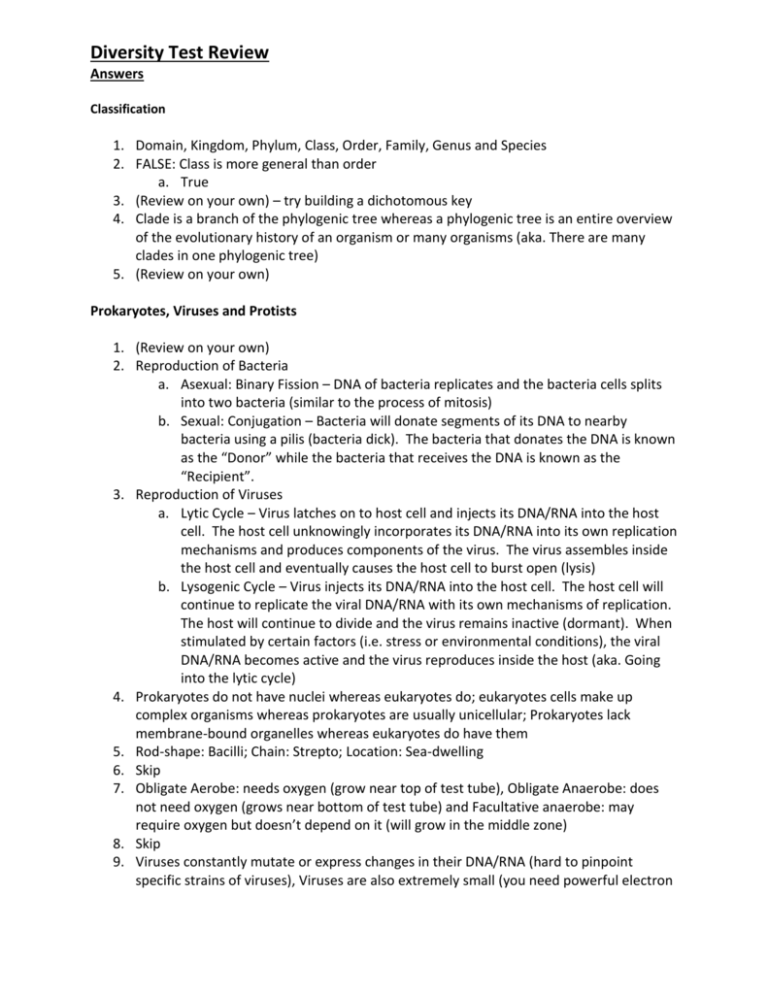
Diversity Test Review Answers Classification 1. Domain, Kingdom, Phylum, Class, Order, Family, Genus and Species 2. FALSE: Class is more general than order a. True 3. (Review on your own) – try building a dichotomous key 4. Clade is a branch of the phylogenic tree whereas a phylogenic tree is an entire overview of the evolutionary history of an organism or many organisms (aka. There are many clades in one phylogenic tree) 5. (Review on your own) Prokaryotes, Viruses and Protists 1. (Review on your own) 2. Reproduction of Bacteria a. Asexual: Binary Fission – DNA of bacteria replicates and the bacteria cells splits into two bacteria (similar to the process of mitosis) b. Sexual: Conjugation – Bacteria will donate segments of its DNA to nearby bacteria using a pilis (bacteria dick). The bacteria that donates the DNA is known as the “Donor” while the bacteria that receives the DNA is known as the “Recipient”. 3. Reproduction of Viruses a. Lytic Cycle – Virus latches on to host cell and injects its DNA/RNA into the host cell. The host cell unknowingly incorporates its DNA/RNA into its own replication mechanisms and produces components of the virus. The virus assembles inside the host cell and eventually causes the host cell to burst open (lysis) b. Lysogenic Cycle – Virus injects its DNA/RNA into the host cell. The host cell will continue to replicate the viral DNA/RNA with its own mechanisms of replication. The host will continue to divide and the virus remains inactive (dormant). When stimulated by certain factors (i.e. stress or environmental conditions), the viral DNA/RNA becomes active and the virus reproduces inside the host (aka. Going into the lytic cycle) 4. Prokaryotes do not have nuclei whereas eukaryotes do; eukaryotes cells make up complex organisms whereas prokaryotes are usually unicellular; Prokaryotes lack membrane-bound organelles whereas eukaryotes do have them 5. Rod-shape: Bacilli; Chain: Strepto; Location: Sea-dwelling 6. Skip 7. Obligate Aerobe: needs oxygen (grow near top of test tube), Obligate Anaerobe: does not need oxygen (grows near bottom of test tube) and Facultative anaerobe: may require oxygen but doesn’t depend on it (will grow in the middle zone) 8. Skip 9. Viruses constantly mutate or express changes in their DNA/RNA (hard to pinpoint specific strains of viruses), Viruses are also extremely small (you need powerful electron microscopes to see them), Viruses are NOT living organisms so they do not follow binomial nomenclature names 10. Amoebas move using their pseudopodia (extensions of cytoplasms) and also their cilia (hair like structures). Ciliates primarily use their cilia. Zooflagellates use flagella (whiplike tail structure). 11. Some bacteria do not contain nuclei whereas all protists do. Protists mainly differ by the locations and method of movement in comparison to bacteria. Protists are in their own kingdom as most are unicellular. Some are plant-like , like euglenoid and the Euglena and thus are autotrophs/photosynthetic. The Euglena seemd animal-like too as it moved with a flagella. Ciliates such as the Paramecium move using cilia and search for food and are therefore consumers or heterotrophs. Amoebas move by extensions of the cytoplasm called pseudopodia 12. Asexual: split apart similar to the process of mitosis. Sexual reproduction: requires a mate and transferral of DNA. Other Kingdoms that have similar reproduction manners include Bacteria and Fungi. Fungi, Plants and Animals 1. Skip 2. Hyphae – cells of fungi that help the fungi gain nutrients and water. A network of hyphae is known as mycelium. 3. The fruiting body contains all the reproductive structures for a typical fungus. 4. Skip 5. Fungi can break down and decompose dead organic matter. They help restore nutrients back into the soil or ground. However, they can also be parasitic because they can damage living organisms by feeding/stealing their nutrients. 6. Plants are autotrophic (photosynthetic) whereas fungi are heterotrophs meaning that they get their nutrients by consuming other organisms or dead things. Many fungi depend on Oxygen whereas Plants intake carbon dioxide. 7. A symbiotic relationship occurs between two species that live in the same environment and help each other to carry out vital functions. Mycorrhizae networks of fungi roots help plants to reach further into deeper parts of the soil while the fungi is able to gain water and other nutrients by growing in close proximity with plant roots. Plants 1. 2. 3. 4. Skip Skip Skip Plants have reinforced cell walls that help allow it to stand upright and tolerate natural forces including wind. Their cell walls are primarily made of cellulose. Plant can grow tall in order to maximize their ability to capture sunlight. Plant cells also have large vacuoles to help them store large amounts of water. 5. Angiosperms are plants that produce flowers and fruits. Fruits contain seeds (i.e. Apple trees, Peaches, Oranges, Sunflowers). Gymnospermare plants that have needle-like leaves and produce seeds that are not encased with fruits. Pine trees have seeds that are inside pine cones. 6. You don’t need to know this… Animals 1. Skip 2. (Review on your own – pay attention to major animal phyla from powerpoint in class) 3. Sponges don’t have tissues or organelles whereas cnidaria do. Sponges are immobile (cannot move) whereas some cnidaria are mobile. Sponges are able to filter water whereas Cnidaria do not. (Cnidaria examples include anemones and jellyfish). 4. Skip 4 - 10 11. All animals are made up of cells (multicellular), all react and respond to their environment, they have the capability to reproduce (sexually), they can use energy and metabolize, they can grow and develop, depend on energy from the sun (but they are heterotrophic), all animals need to respire (main source includes oxygen) Treatments for infections - Bacterial infection: recommended to use antibiotics, antibiotic cream (polysporin) - Viral infection: cannot use antibiotics, rather have immune system fight (plenty of rest). Get vaccinated in order to prevent viral infections (before you get infected). - Fungal infection: use antifungal medication (treatment for athlete’s foot)


